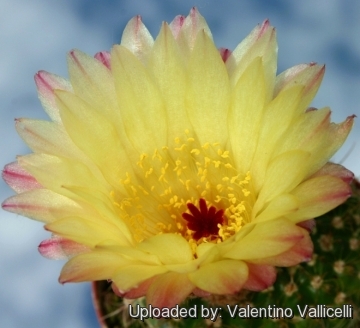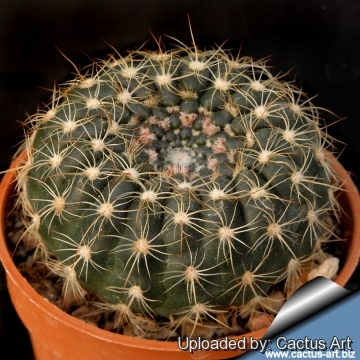Accepted Scientific Name: Parodia concinna (Monv.) N.P.Taylor
Bradleya 5: 93 (1987)

Notocactus concinnus var. yerbalitoensis Photo by: Valentino Vallicelli
Origin and Habitat: Yerbalito, Cerro Largo, Uruguay.
Synonyms:
See all synonyms of Parodia concinna
back
Accepted name in llifle Database:Parodia concinna (Monv.) N.P.TaylorBradleya 5: 93 (1987)Synonymy: 50
back
Description: Parodia concinnaSN|3536]]SN|3536]] var. yerbalitoensis|SN|20507]] (also spelled yerbalitensis or gerbalitoensis) is a local form of the wide ranging and very variable Parodia concinnaSN|3536]]SN|3536]]. The differences with other Parodia concinnaSN|3536]]SN|3536]] are in reality very minimal and most botanist agree on the fact that both should all be included in the Parodia concinnaSN|3536]]SN|3536]], and the two plants are not readily distinguishable, if not for the geographical provenance.
Habit: It is small cactus species forming a flattened and much-ribbed sphere.
Stem: Simple, broadly globular or somewhat depressed at apex, eventually longer in age, about 3-10 cm tall, and 4-10 cm across, light or dark glossy green, ribbed and warty at the top.
Ribs: about 16 to 20, with somewhat conspicuous chin-like tubercles between the areoles
Areoles: Young areoles white-felted.
Spines: 10 to 12, spreading, setaceous, hair-like to bristle-like, some more or less curved to twisted, brown, reddish or partly whitish to yellowish often poorly differentiated as centrals and radials.
Radial spines: 9 to 25, about 5 to 7 mm long adpressed and interlaced.
Central spines: 1-4(-6), one much longer (1-2,5cm ), spreading or turned downward.
Flowers: 1-5 produced together at the apex, bright yellow, funnel-shaped, large, about 5 to 8 cm across. Outer perianth-segments narrow, acute, reddish, inner perianth-segments oblong, yellow almost transparent, except the reddish tips, acute. Stigma-lobes scarlet. Scales on the ovary hairy in their axils. Perianth-tube slender.
Blooming season: Summer.
Fruit: Green ovoid to globular approx. 1,5 cm cm long, thin-walled, splitting or disintegrating at maturity with more than 100 seeds per fruit.
Seed: 0,8-1 mm, bell-shaped broadest at the hilum, somewhat, tuberculate, shiny and black.
Subspecies, varieties, forms and cultivars of plants belonging to the Parodia concinna group
 Notocactus agnetae var. aureispinus Vliet: like subsp. agetae but with thin yellowish spines.. Distribution: Uruguay (Rocha, Lavalleja and Maldonado).
Notocactus agnetae var. aureispinus Vliet: like subsp. agetae but with thin yellowish spines.. Distribution: Uruguay (Rocha, Lavalleja and Maldonado). Notocactus concinnus var. apricus (Arechav.) P.V.Heath: has stems spherical 3-4 cm wide, apex umbilicate covered with interlocking brownish-reddish spines. Distribution: surroundings of Maldonado, Uruguay.
Notocactus concinnus var. apricus (Arechav.) P.V.Heath: has stems spherical 3-4 cm wide, apex umbilicate covered with interlocking brownish-reddish spines. Distribution: surroundings of Maldonado, Uruguay.- Notocactus concinnus f. joadii (Arechav.) Havlíček
 Notocactus concinnus var. yerbalitoensis W.Prauser: has about 20 ribs. Distribution: Yerbalito, Cerro Largo, Uruguay.
Notocactus concinnus var. yerbalitoensis W.Prauser: has about 20 ribs. Distribution: Yerbalito, Cerro Largo, Uruguay. Parodia concinna (Monv.) N.P.Taylor: has 16-20 tubercled ribs, 9-25 bristle-like radial spines and 1-4(-6), one much longer (1-2,5cm ), spreading or turned downward centrals. Distribution: Southern Brazil, Uruguay.
Parodia concinna (Monv.) N.P.Taylor: has 16-20 tubercled ribs, 9-25 bristle-like radial spines and 1-4(-6), one much longer (1-2,5cm ), spreading or turned downward centrals. Distribution: Southern Brazil, Uruguay. Parodia concinna subs. agnetae (Vliet) Hofacker: has dense thin brownish spines and more closely set areoles. Distribution: Uruguay (Rocha, Lavalleja and Maldonado).
Parodia concinna subs. agnetae (Vliet) Hofacker: has dense thin brownish spines and more closely set areoles. Distribution: Uruguay (Rocha, Lavalleja and Maldonado).- Parodia concinna subs. blaauwiana (Vliet) Hofacker
 Notocactus concinnus var. yerbalitoensis Photo by: Valentino Vallicelli
Notocactus concinnus var. yerbalitoensis Photo by: Valentino Vallicelli Notocactus concinnus var. yerbalitoensis Photo by: Cactus Art
Notocactus concinnus var. yerbalitoensis Photo by: Cactus ArtCultivation and Propagation: It is relatively easy to grow on its own roots.
Soil: Grow it in an open sandy-gritty cactus compost.
Pots: It needs a relatively shallow pot to accommodate its fibrous roots and provide a very good drainage. It may stay in the same pot for many years.
Watering: Water in moderation, it prefer a completely dry place during winter. Mature individuals easily rot and die especially after planting so be extremely cautious with watering. Keep dry in winter or when night temperatures remain below 10° C. Water it less than average if in bigger pots.
Special need: Provide very good ventilation. Nearly all problems occur as a result of overwatering and poor ventilation, especially when weather conditions are dull and cool or very humid.
Fertilization: Feed them once during the growing season with a fertilizer specifically formulated for cactus and succulents (high potash fertilizer with a dilute low nitrogen), including all micro nutrients and trace elements diluted to ½ the strength recommended on the label. They thrive in poor soils and need a limited supplies of fertilizer to avoid the plants developing excess vegetation, which is easily attacked by fungal diseases.
Exposure: It will do its best with lots of sun and become stressed with inadequate light which could result in poor growth and unnatural shape.
Hardiness: It likes warmth (recommended minimum winter temperature 5° C) however plants kept perfectly dry can can survive low temperatures, approx. -5°, but for safe cultivation it is best to avoid freezing temperatures.
Use: This is a good pot plant suited for a non heated green house. It can be also cultivated outdoors in raised beds, terraces if sheltered from winter rain. This cactus continues to be, a particular prize among collectors
Pests & diseases: These cacti may be attractive to a variety of insects, but plants in good condition should be nearly pest-free, particularly if they are grown in a mineral potting-mix, with good exposure and ventilation. Nonetheless, there are several pests to watch for:
- Red spiders: Red spiders may be effectively rubbed up by misting the plants from above.
- Mealy bugs: Mealy bugs occasionally they develop aerial into the new leaves and flowers with disfiguring results, but the worst types develop underground on the roots and are invisible except by their effects.
- Rot: Rot is only a minor problem if the plants are watered and “aired” correctly. If they are not, fungicides won't help all that much.
Propagation: Seeds. The seeds can be sown in pots of fine, well-drained sandy soil, any time during the spring when temperatures are warm. Cover the seeds with a fine layer of grit and water from below with a fungicide to prevent damping off. For the 1-2 weeks cover the pots with a sheet of glass/clear perspex to keep the humidity levels high. Remove the glass and replace it with light shade-cloth and mist once or twice a day for the next two weeks after which most seeds should have germinated. From then on mistings can be reduced to every second and then every third day as the little plants grow.












